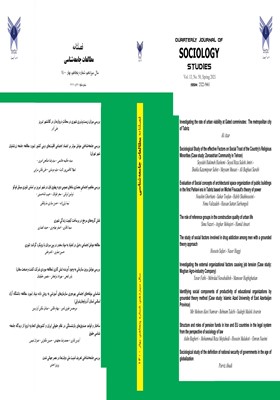جامعه شناسی آموزش عالی و ارائه مدل مدیریتی برای دانشگاه های دولتی (دانشگاه های سطح یک ایران)
محورهای موضوعی : جامعه شناسی
زهرا سامانی
1
![]() ,
صادق ملکی آوارسین
2
*
,
صادق ملکی آوارسین
2
*
![]() ,
زرّین دانشورهریس
3
,
زرّین دانشورهریس
3
![]()
1 - دانشجوی دکتری مدیریت آموزشی، دانشگاه آزاد اسلامی واحد تبریز، تبریز،
2 - دانشیارگروه علوم تربیتی دانشکده علوم تربیتی و روانشناسی دانشگاه آزاد اسلامی تبریز ایران نویسنده مسئول s.maleki@iaut.ac.ir
3 - استاد یار گروه علوم تربیتی، دانشکده علوم انسانی دانشگاه آزاد اسلامی واحد تبریز، تبریز، ایران.
کلید واژه: ", جامعه شناسی آموزش عالی", مدیریت دانشگاهی", سیاست گذاری", ارزیابی کیفیت",
چکیده مقاله :
هدف این پژوهش ارائه مدل مدیریتی با نگاهی جامعه شناختی برای دانشگاه های سطح یک ایران در سال 1398 است. روش تحقیق در این پژوهش از نوع کمّی (توصیفی- همبستگی) است. جامعه پژوهش اعضای هیأت علمی دانشگاه های سطح یک ایران بودند که با استفاده از روش نمونه گیری طبقه ای نسبی، 182 نفر به عنوان نمونه انتخاب شدند. ابزار اندازه گیری، پرسش نامه محقق ساخته در56 گویه بود. به منظور بررسی پایایی ابزار اندازه گیری از آلفای کرونباخ، پایایی ترکیبی، پایایی RHO_A و پایایی اشتراکی استفاده شده است. برای بررسی روایی محتوایی از نظر اساتید خبره در رشته آموزش عالی و برای ارزیابی روایی سازه از میانگین واریانس استخراج شده استفاده شده است. داده ها در نرم افزارهای SPSS و LISREL با روش مدل سازی معادلات ساختاری تحلیل شدند. بر اساس نتایج به دست آمده در تحلیل عاملی مرتبه اول، 7 مولفه با 38 شاخص تایید شد و در تحلیل عاملی مرتبه دوم، مولفه های ارزیابی کیفیت، سیاست گذاری، الگوهای مدیریت و رهبری، سازو کارهای مالی، خودمختاری، برنامه ریزی و نظارت دولتی، از بار عاملی کافی برای پیش بینی برخوردار بودند. مقدار شاخص GOF(0.569)، نشان داد که الگوی طراحی شده برای مدیریت دانشگاه های دولتی از برازش مطلوبی برخوردار است.
The purpose of this study is to Present a management model with a sociological perspective for public universities of Iran (Top universities) in 2018. The presented research was a quantitative descriptive-correlational study. The research population was the faculty members of level-one universities in Iran. Using proportionate stratified random sampling, 182 people were selected as the sample. The measurement instrument was a researcher-made questionnaire with 56 items. Cronbach's alpha, combined reliability, RHO_A reliability, and shared reliability were used to evaluate the reliability of the measuring instrument. The mean-variance was used to evaluate the content validity from the point of view of professors in the field of higher education and to evaluate the construct validity. Data were analyzed in SPSS and LISREL software by structural equation modeling. Based on the results obtained in the first-order factor analysis, 7 components with 38 indicators were approved, and in the second-order factor analysis, the components of quality evaluation, policy-making, management and leadership patterns, financial mechanisms, autonomy, government planning, and oversight, Had a sufficient factor to predict. The value of the GOF index (0.569) showed that the model designed for public universities' management is a good fit.
_||_
Agha Tabar Rudbari and Yousefi Saeedabadi, Reza. (2016). Examining the academic independence gap from the perspective of academic experts (a case study of Noshirvani University of Medical Sciences and Technology). Monthly Education Strategies in Medical Sciences, year 10, no. 5, P.p: 334-344.
13.Khaniki, Hadi., Farstakhah, Maghsoad., ghadimi, Esmaiel and Rasouli, Mohammad Reza. (2012). A glance at the sociology of higher education and the university system of Iran. Social Science Quarterly. No. 69, pp. 4-11.

